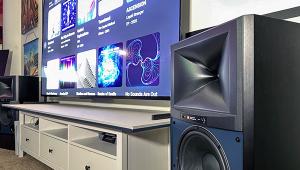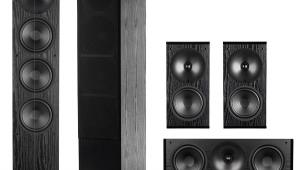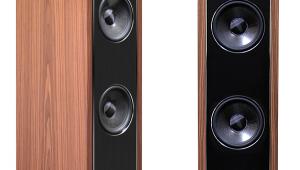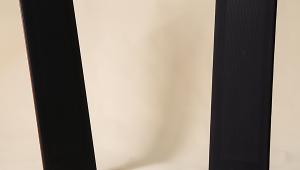Dynaudio Special 25 & Sub 500 surround speaker system
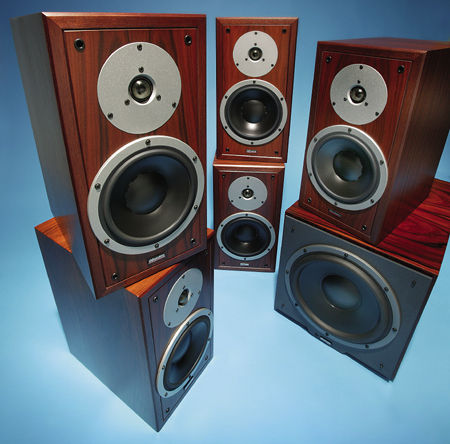
For the May 2001 SGHT, I reviewed a speaker that Dynaudio now describes as a "predecessor product": the Contour 1.3 Mk.II SE. It was an excellent example of what I saw as the hallmark of Dynaudio sound: cool and restrained, but detailed. I liked them so much I bought them.
For this surround system, Dynaudio sent me five samples of their latest no-compromise compact speaker, the Special 25. I had a matched set of fronts, rears, and center. Dynaudio writes of the Special 25 with unrestrained superlatives: "The finest compact loudspeaker ever crafted by Dynaudio." A speaker measuring only 16.7 by 8.8 by 13.8 inches but costing $4800/pair had better be very good for anyone to consider using five of them in a home theater. The cost of my review system was $12,000—not including the subwoofer.
My reference home-theater speaker system, the Infinity Prelude MTS, is—at least on paper—far more capable. Each of its two large front towers has a 12-inch powered subwoofer in its base; the center and rear speakers are matched, though they lack subs. That setup cost $12,000 when I bought it, $16,000 now.
The comparison may not be as outrageous as it sounds. It's quite a bit more difficult to get superb, near–full-range sound from a tiny cabinet than from a big one. The former is an art, and if the results are superb, the price is likely to be high. Anyone with lots of room and no family concerns—my situation—might opt for a big MTS system or something similar. But that's not a viable option for many others, for whom a superb small speaker might be valued more highly, and be worth the price.
What They Are
The Special 25 is smaller than a paper grocery bag or a desktop computer system—and about half the size of the old Dynaco bookshelf speakers that, in my youth, were the standard for compacts. Each cabinet has an 8-inch woofer and 1.1-inch soft-dome tweeter—the same tweeter Dynaudio uses in two of its high-end Confidence models. The company says the woofer is "based on the drivers" used in Dynaudio's top-of-the-line Evidence system, and claims virtually flat (+/-3dB) bass down to 35Hz. I'll leave it to the test-bench measurements to determine the truth of that. The crossover frequency is 2400Hz.
The Special 25's cabinet walls are heavily braced inside with corner blocks and damping plates, and the low end is reflex-loaded by a horn-shaped, rear-facing port. (Foam blocks are included to plug the ports in case the speakers are placed close to a wall.) If you use the Special 25s only for music listening, perhaps you could live without that bottom octave of bass. I do so with my Contour 1.3 Mk.II SEs, which I use in another room, for music only. Sometimes I'm wistful for that deep bass, but I have no room for a subwoofer there.
Still, I don't miss the bass as much as I would in my theater. So, for use as a home theater system, a subwoofer is absolutely necessary—and Dynaudio kindly provided a sample of its new Sub 500, a relatively compact sub with a 12-inch woofer and a 250W internal amp. The Sub 500's $1900 cost pushes the total system price to $13,900.
Where They Went
I placed the Sub 500 in the same spot, near a corner, where sits my Velodyne FSR-18 (with 18-inch woofer)—on top of it, in fact. Before doing anything else, I used a sound-pressure meter and test tones to see if the Dynaudio sub could in fact produce audible sound at 20Hz. There was no dropoff at 20Hz—the Sub 500 was able to belt out a 20Hz tone at the same sound-pressure level as it did a 90Hz tone. There were other variations along the scale that I discuss later, but there was no question about this sub's ability to fill out the bottom octave that the Special 25 cannot provide alone.
For music, my Sony DVP-NS999ES DVD/SACD/CD player crossed over the Special 25s to the Sub 500 at 80Hz. For movie soundtracks, my Lexicon MC 12B (v.3) preamp-processor performed the same function at the same frequency. The Special 25s were placed atop the subwoofer bases of my front Infinity speakers, and on stands immediately below my rear surrounds. I moved the Infinity center-channel speaker from its shelf near the floor and replaced it with a Special 25. The Dynaudios thus were in almost exactly the same spots as the Infinitys—positions for which my system is finely tuned.
What They Did
First I listened to the Special 25s without the Sub 500, to see what kind of bass they offered on their own. I played the Robert Hohner Percussion Ensemble's Far More Drums SACD (DMP SACD10). I'm not sure who would listen to this CD except as a test of bass capability—it's a collection of booming drum solos or near-solos and little else.
The Special 25s put on a credible performance. My first impression was that the bass was tight, wonderfully articulated, even gutsy. But I'd played this disc a few times before, and knew that its lowest tones were missing. Still, it was amazing to look at these little speakers and believe that the strong bass I was hearing was coming from such small boxes.
But usually, when I review a speaker system, I try not to listen to SACDs first—it just prejudices my view of standard CDs. So after the Hohner Ensemble had finished bashing away, I moved to a mix of CDs. First up was some hard rock, The Best of Wishbone Ash (MCA 11620), from a group known for long, improvised solos on electric guitar—music I enjoyed when I was in college. Through the Dynaudio system, the guitars on "The Pilgrim" were brassy and overwrought, so forward that the sound was harsh and unpleasant. This was surprising—I'd never noticed this in previous playings of this disc. I immediately took the disc upstairs and played it in my music room with the Dynaudio Contour 1.3 Mk.II SEs, which I know to be patently cool, laid-back speakers. When I played "The Pilgrim" there, the same guitar riff was a bit forward and bright, but not at all unpleasant. Quite a contrast.
This is just the sort of brassiness that can indicate that a speaker has not yet been properly broken in. Dynaudio had broken in the Special 25s for several days before sending them to me, but I decided maybe that hadn't been enough. I put several different discs on Repeat play and let the speakers cook for another 60 hours (though not at super-high volumes—not possible in my house), then played "The Pilgrim" again. The brassiness was damped down a bit but was still quite pronounced, still unnatural. Maybe after many weeks of burn-in it would diminish even more, but I have no way of knowing.
 Wishbone Ash proved to be the demon for these speakers. I played other CDs, including Keith Jarrett's The Köln Concert (ECM 1064/65), a long, liquid piano solo—there, the same midrange sounded bloated and overfull, though never harsh. Other CDs demonstrated more or less of this same midrange trait.
Wishbone Ash proved to be the demon for these speakers. I played other CDs, including Keith Jarrett's The Köln Concert (ECM 1064/65), a long, liquid piano solo—there, the same midrange sounded bloated and overfull, though never harsh. Other CDs demonstrated more or less of this same midrange trait.
While I had issues with the midrange, the high end positively sparkled, airy and grain-free. And consistently, the speakers provided a full, well-defined low end that was surprising for their size.
I plugged in the Sub 500 and played some of the same music again, including Far More Drums. Suddenly the music had a floor and a heft it had lacked before. That sub was convincing. But when I measured it with test tones, I found significant peaks at certain frequencies, particularly at 56Hz, where my meter registered 96dB compared to 83–84dB over most of the rest of the range. With test tones and movie soundtracks, the Sub 500 boomed at that frequency, losing all sense of precise definition.
I'm not going to draw conclusions from this; the problem could be a function of the Sub 500's placement and/or my room. Dynaudio does provide a nice little remote control that allows the user to adjust from the listening position several of the Sub 500's parameters—though none that seemed to affect the boom noted above.
I watched several movies, such as the second and third in the Matrix series, Reloaded and Revolutions. Both have thrumming bass tones that seem to be omnipresent and give the movies a thrilling floor that the Sub 500 was able to render without quibble or complaint. Nothing was missing. Revolutions, particularly, has a variety of scenes in which the midrange—beyond the portrayals of human voices—matters. The squid-like Sentinels emit squeaks and tones, machines hum, people sing. All of this was convincing through the Special 25s—accompanied by the Sub 500, these little speakers offered a broad, deep soundstage. Had I walked into a darkened room and sat down to watch this movie, I would have been shocked to see, when the lights came up, that I'd been listening to such small speakers.
What It All Means
I can't say that movie soundtracks are the best tests of such precise speaker-performance parameters as an occasional brassiness. Sounds fly by, and I'm never sure exactly what the engineers intended. In any case, while watching movies I was never bothered by that issue. I never had a problem with the clarity of voices or other effects in the midrange. At the same time, the Special 25's other strengths held firm.
But even with my reservations, and even at this price, the Dynaudio Special 25 (with the accompanying Sub 500) is a little wonder. If you're looking for a compact but impressive home theater system, look here.
- Log in or register to post comments




